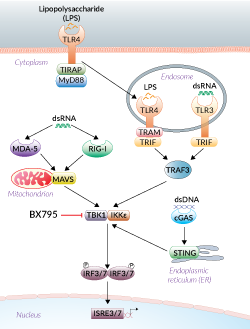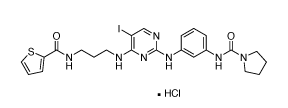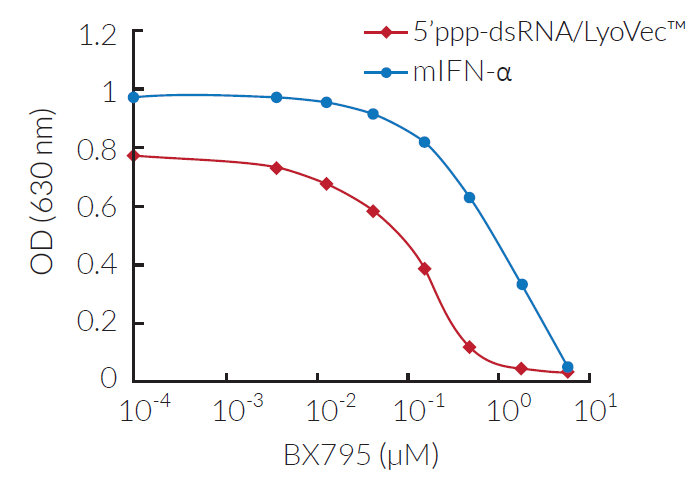BX795
| Product | Unit size | Cat. code | Docs. | Qty. | Price | |
|---|---|---|---|---|---|---|
|
BX795 TBK1/IKKε inhibitor - InvitroFit™ |
Show product |
5 mg 2 x 5 mg |
tlrl-bx7
|
|
TBK1/IKKε inhibitor

TBK1/IKKε signaling inhibition by BX795
BX795 is a potent inhibitor of the noncanonical IkB kinases TANK-binding kinase 1 (TBK1) and IkappaB kinase-epsilon (IKKε) [1]. TBK1 and IKKε play a central role in the innate immune response. Notably, these noncanonical IkappaB kinase homologs are essential components of the interferon regulatory factor (IRF) signaling pathway.
Mode of action:
BX795 inhibits the catalytic activity of TBK1/IKKε by blocking their phosphorylation. BX795, an aminopyrimidine compound, was developed as an inhibitor of 3-phosphoinositide-dependent kinase 1 (PDK1) [1].
Studies have demonstrated that BX795 is a potent inhibitor of the IKK-related kinases, TANK-binding kinase 1 (TBK1), and IKKε, and hence of IRF3 activation and IFN-β production [2, 3].
Key features:
- A potent inhibitor of TBK1 and IKK-ε
- InvitroFit™ grade: each lot is highly pure (≥95%) and functionally tested
References:
1. Feldman RL. et al., 2005. Novel Small Molecule Inhibitors of 3-Phosphoinositide- dependent Kinase-1. J. Biol. Chem., 280: 19867 - 19874.
2. Clark K. et al., 2009. Use of the Pharmacological Inhibitor BX795 to Study the Regulation and Physiological Roles of TBK1 and I{kappa}B Kinase {epsilon}: a distinct upstream kinase mediates Ser-172 phosphorylation and activation. J. Biol. Chem., 284: 14136 - 14146.
3. Bain J. et al., 2007. The selectivity of protein kinase inhibitors: a further update, 408: 297-315.
Specifications
CAS number: 1472611-45-2
Working concentration: 100 nM - 10 μM
Solubility: DMSO (10 mg/ml)
Formula: C23H26IN7O2S • HCl
Molecular weight: 627.93 g/mol
Quality control:
- Purity ≥ 95% (UHPLC)
- The inhibitory activity has been validated using cellular assays.
- The absence of bacterial contamination (e.g. lipoproteins and endotoxins) has been confirmed using HEK-Blue™ TLR2 and HEK-Blue™ TLR4 cells.
Contents
BX795 is available in two quantities:
- tlrl-bx7: 5 mg
- tlrl-bx7-2: 10 mg (2 x 5 mg)
![]() BX795 is shipped at room temperature.
BX795 is shipped at room temperature.
![]() Upon receipt, store at -20°C.
Upon receipt, store at -20°C.
Details
TBK1 /IKKε
TANK-binding kinase 1 (TBK1; also known as NF-κB activating kinase/NAK and T2K) is a multifunctional serine/threonine-protein kinase that belongs to the non-canonical IκB kinase family, together with its close homolog IkB kinase ε (IKKε, also known as IKKi). TBK1 plays an important role in the regulation of many cellular processes, including innate immunity, inflammatory cytokine production, autophagy, mitochondrial metabolism, and cell survival/proliferation [1].
In innate immune signaling, TBK1 acts as an integrator of receptor-mediated pathogen detection signals and as an interferon (IFN) response modulator [2, 3]. Viral, bacterial, or tumor DNA activate STING (stimulator of interferon genes protein), which triggers TBK1 signaling and results in the activation of the transcription factors IRF3 (IFN regulatory factor 3)and IRF7 to induce the expression of type-I IFNs. Additionally, TBK1 plays a role in other signaling pathways triggered by other innate adaptors, such as MAVS (mitochondrial antiviral signaling protein) and TRIF (TIR-domain-containing adapter-inducing interferon-β).
References:
1. Herhaus L., 2021. TBK1 (TANK-binding kinase 1)-mediated regulation of autophagy in health and disease. Matrix Biol. 100-101:84-98.
2. Durand J.K. et al., 2018. Roles for the IKK-related kinases TBK1 and IKKε in cancer. Cells. 7(9):139.
3. Runde AP. et al., 2022. The role of TBK1 in cancer pathogenesis and anticancer immunity J Exp Clin Cancer Res . 41(1):135.
Chemical structure of BX795







